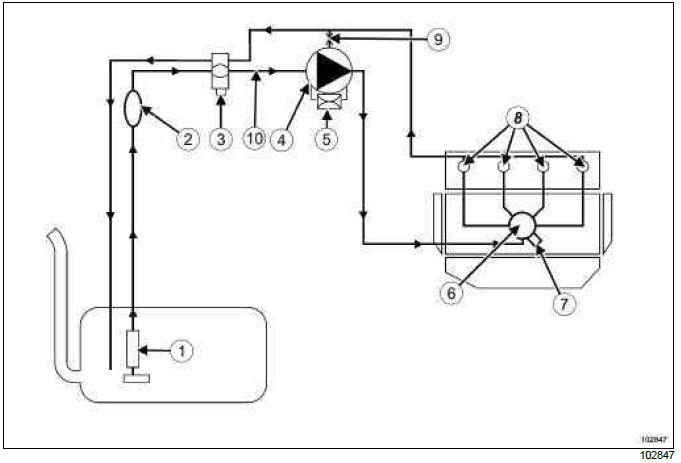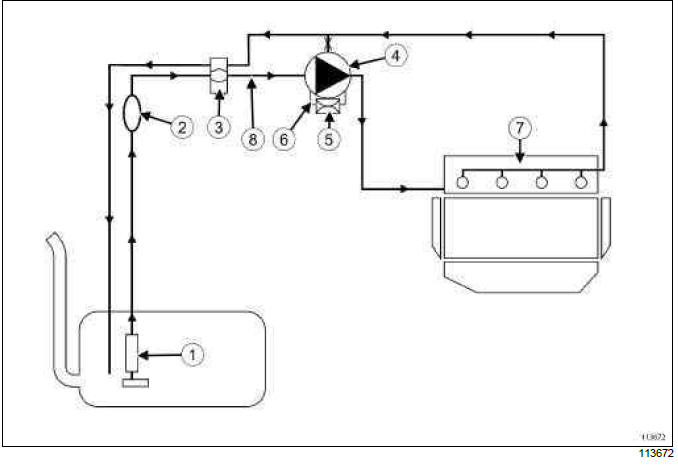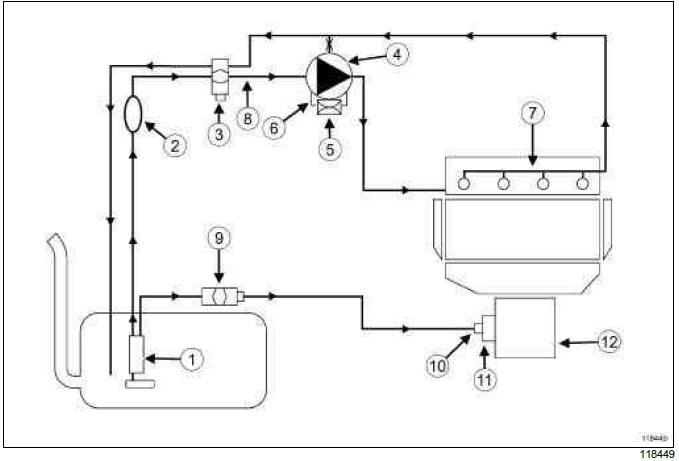Renault Clio: Diesel supply circuit: Operating diagram
K9K, and 750 or 752 or 766 or 768
Operating diagram of the diesel fuel supply circuit

The circuit comprises:
- a sender (1),
- a priming bulb (2),
- a fuel filter (3) that can be fitted with a water detection sensor,
- a high pressure pump (4) with a built-in mechanical low pressure pump (transfer pump),
- a fuel flow actuator (5),
- an injector rail (6) fitted with a diesel pressure sensor (7),
- four injectors (8),
- a venturi tube (9),
- a bleed screw (10),
- various sensors,
- an injection computer.
IMPORTANT
Loosening a high-pressure pipe union when the engine is running is strictly prohibited.
WARNING
It is forbidden:
- to dismantle the interior of the pump or injectors.
Only the fuel flow actuator, the diesel fuel temperature sensor and the venturi tube can be replaced,
- to remove the pressure sensor from the fuel rail (because of circuit contamination problems). If the pressure sensor fails, the pressure sensor, the rail and the five high pressure pipes must be replaced.
Only the flow actuator, the diesel fuel temperature sensor and the venturi tube can be replaced.
K9K, and 764
Operating diagram of the diesel fuel supply circuit

The circuit comprises:
- a sender (1),
- a priming bulb (2),
- a fuel filter (3) which may be fitted with a water detection sensor,
- a high pressure pump (4) with a built-in mechanical low pressure pump (transfer pump),
- a pressure regulator (5), mounted on the high-pressure pump,
- a flow regulator (6), mounted on the high-pressure pump,
- an injector rail (7) fitted with a pressure sensor,
- a bleed screw (8),
- four injectors,
- various sensors,
- an injection computer.
IMPORTANT
Loosening a high pressure pipe union when the engine is running is strictly prohibited.
WARNING
It is forbidden:
- to dismantle the interior of the pump or injectors.
- to remove the pressure sensor from the fuel rail (because of circuit contamination problems). If the pressure sensor fails, the pressure sensor, the rail and the five high pressure pipes must be replaced,
- to dismantle the flow regulator solenoid and the pressure regulator solenoid on the high-pressure pump.
K9K, and 772
Operating diagram of the diesel fuel supply circuit

The circuit comprises:
- a pump - sender (1),
- a priming bulb (2),
- a fuel filter (3) that can be fitted with a water detection sensor,
- a high pressure pump (4) with a built-in mechanical low pressure pump (transfer pump),
- a pressure regulator (5) mounted on the high pressure pump,
- a flow regulator (6) mounted on the high pressure pump,
- an injector rail (7) fitted with a pressure sensor,
- a bleed screw (8),
- four injectors,
- various sensors,
- an injection computer,
- a particle filter injector fuel filter (9),
- a diesel injector (10) on the catalytic pre-converter,
- a diesel injector cooler (11),
- a catalytic pre-converter (12).
IMPORTANT
Loosening a high-pressure pipe union when the engine is running is strictly prohibited.
WARNING
It is forbidden:
- to dismantle the interior of the pump or injectors.
- to remove the pressure sensor from the fuel rail (because of circuit contamination problems). If the pressure sensor fails, the pressure sensor, the rail and the five high pressure pipes must be replaced,
- to dismantle the flow regulator solenoid valve and the pressure regulator solenoid valve on the high pressure pump.

